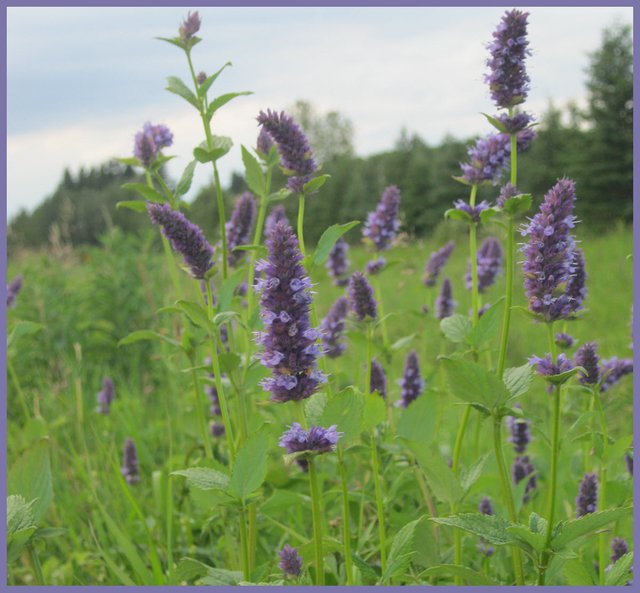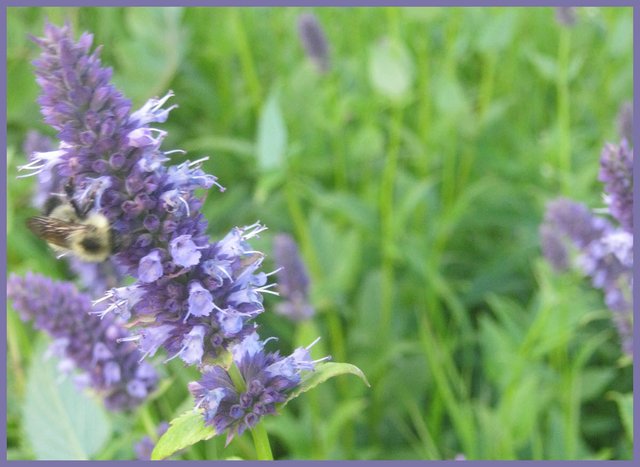Celebrating Healing Plants - Issue #2 - Giant Hyssop (Agastache Foeniculum)
The beautiful giant hyssop graces our lane way and the ditches of the gravel road by our house in the Boreal forest of Saskatchewan, Canada. I also cultivate the anise hyssop (commonly known as "licorice mint") in my garden. This plant is identical to the wild variety but it has a stronger anise or licorice flavor which I love in teas.
Agastache comes from the Greek word AGAN, meaning very much and STACHYS, a spike. As you can see there is very many tiny flowers making up the spike blossom of the hyssop. I refer to it as the hyssop but it is not to be confused with the Hyssopus Officialis which is native to central and southern Europe and has different medicinal qualities as to the giant hyssop (Agastache Foeniculum).
Giant Hyssop (Agastache Foeniculum)
I love the beautiful blue flower and add it to my collection of dried flowers to add color to my home in the winter. It is also one of the tastiest edible flowers for adding to salads or the dried leaves and flowers for flavoring meat.
The bees love it too and it is often cultivated as a honey plant in the United States.
Mosquitoes on the other hand do not like the smell, so it can be used as a natural repellent!
Giant Hyssop (Agastache Foeniculum) often cultivated by bee keepers
The giant hyssop has many medicinal qualities and has been used traditionally by many Native American tribes acording to Robert Dale Rogers in his book "Medicinal Plants of the Prairies".
The Cree used it for those coughing up blood. Flowers were often included in Cree medicine bundles.
Other Native tribes used the plant to induce sweat in steam baths; and to correct a dis-spirited heart.
The Cheyenne drank the cooled tea for chest pains; while the Chippewa used root infusions for colds, chest pain and coughs.
The hyssop is part of the mint (Lamiaceae) family and is similar in action to other mints. It has a diaphoretic action, which produces or promotes sweating. This sweating helps the skin to eliminate waste from the body which in turn helps support the work of the kidney and can be used in treatments of kidney problems.
Again Robert Dale Rogers in his book "Medicinal Plants of the Prairies" lists the
Medicinal Constituents
Methyl chavicol, methone, mycrene, pulegone, limonene and beta-pinene
It is used to dispel hot and damp conditions that give oppressed feelings in the chest, abdominal pains, vomiting and diarrhea. It relieves fevers, chills, and the nausea that accompanies the flu.
The plant also remedies various arthritic conditions that are exaggerated by damp and cold weather.
It would be fair to generalize, that giant anise hyssop is a cardiovascular tonic.
Recipes
Cordial
Fill a jar half full with the leaves and flowers of the anise hyssop.
Fill the rest of the way with vodka, cover and let sit for a month. Shaking occasionally.
Strain out the leaves and flowers and sweeten with a sugar syrup to taste.
this gives a lovely anise flavored dessert cordial
Tincture
Follow the same first steps as in making the Crdial (above) covering the leaves and flowers with vodka for a month, then straining out the plant parts and you will have a tincture.
Doses: Use 10-20 drops up to six times daily for acute conditions, up to four times in chronic conditions.
Jams and Jellies
Puree anise Hyssop leaves and flowers into fruit mixes for your jams and jellies. It pairs really well with peaches, apricots and berries.
Ice Cream and Custards
Steep sprigs of Anise Hyssop in milk or cream for making ice cream or custards. It also pairs well with chocolate so add it to your hot chocolate.
The photos were taken with my Canon PowerShot A495 which has a zoom lens 3.3x
Issue #1 in Celebrating Healing Plants can be found at: https://steemit.com/health/@porters/celebrating-healing-plants-issue-1-alfalfa-medicago-sativa
If you want to see more blossoms from the Boreal forest I have a 4 part series "Photo Journey Through the Seasons - Wild Blossoms Found in the Boreal Forest"



your blog is very informative, thanks for sharing!
You're welcome!
Beautiful plant!
I did not know that about mosquitoes! Great information share!
Thanks! There are a few plants growing around us that I grab to use for misquito repellents. This one and yarrow are my favorite.
Beautiful x
Thanks!
Hi @porter heard of the plant first time...the flower looks really beautiful....i never saw it in India...as far as i know...might be very rare in India
Posted using Partiko Android
There is different plants that are related to the giant hyssop which may grow in India. It is a common perennial here in moist meadows and the aspen parkland (this is the area where the pictures were taken).
great inspiration, thank you!
You're welcome!
In jams,jellied or ice cream ,hyssop is multi purpose.Knew it first from your post.
Congratulations @porters! You have completed the following achievement on Steemit and have been rewarded with new badge(s) :
Click on the badge to view your Board of Honor.
If you no longer want to receive notifications, reply to this comment with the word
STOPAwesome post! Thank you for the recipes too. Up voted and following!
Glad you enjoyed it!